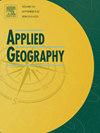Linking ecosystem services trade-offs, human preferences and future scenario simulations to ecological security patterns: A novel methodology for reconciling conflicting ecological functions
IF 4
2区 地球科学
Q1 GEOGRAPHY
引用次数: 0
Abstract
Ecological security patterns (ESPs) are critical for identifying priority protection areas, enhancing ecological flows, and supporting cross-regional sustainable development. However, traditional ESP frameworks often neglect ecosystem service (ES) trade-offs and human preferences, leading to conflicts among ecological functions and unsustainable spatial patterns. This study proposes a novel OWA-ESP-PLUS framework to optimize ecological protection areas by integrating ES trade-offs and human preferences. The ordered weighted averaging (OWA) model, coupled with GIS, simulated the spatial distribution of priority protected areas under varying decision-making risks. The optimal scenario, with the highest average protection efficiency and low human trade-offs was selected. Ecological sources, corridors and pinch points were then identified to establish a cross-regional ESP. To assess its adaptability for future ecological security, the PLUS model simulated three 2030 scenarios: business as usual (BAU), priority economic development (PED), and priority ecological protection (PEP). Results showed that priority protection areas in the optimal scenario promoted 55.9% conservation efficiency while maintaining a balanced spatial configuration. The ESP, consisting of 24 ecological sources, 51 ecological corridors, and 25 pinch points, enhanced landscape connectivity, reduces fragmentation, and minimizes disturbance risk. This framework bridges ES conservation with sustainable spatial management, offering a transferable methodology for ecological planning worldwide.

将生态系统服务权衡、人类偏好和未来情景模拟与生态安全模式联系起来:一种协调相互冲突的生态功能的新方法
生态安全模式(ESP)对于确定优先保护区域、加强生态流动以及支持跨区域可持续发展至关重要。然而,传统的 ESP 框架往往忽视生态系统服务(ES)权衡和人类偏好,导致生态功能之间的冲突和不可持续的空间模式。本研究提出了一种新颖的 OWA-ESP-PLUS 框架,通过整合生态系统服务权衡和人类偏好来优化生态保护区。有序加权平均(OWA)模型与地理信息系统相结合,模拟了不同决策风险下优先保护区的空间分布。选出了平均保护效率最高、人类权衡较低的最优方案。然后确定了生态源、走廊和夹点,以建立跨区域的 ESP。为评估其对未来生态安全的适应性,PLUS 模型模拟了三种 2030 年的情景:一切照旧(BAU)、优先经济发展(PED)和优先生态保护(PEP)。结果表明,最佳方案中的优先保护区在保持空间配置平衡的同时,提高了 55.9% 的保护效率。由 24 个生态源、51 条生态走廊和 25 个夹点组成的 ESP 增强了景观的连通性,减少了破碎化,并将干扰风险降至最低。该框架将生态系统保护与可持续空间管理结合起来,为全球生态规划提供了一种可推广的方法。
本文章由计算机程序翻译,如有差异,请以英文原文为准。
求助全文
约1分钟内获得全文
求助全文
来源期刊

Applied Geography
GEOGRAPHY-
CiteScore
8.00
自引率
2.00%
发文量
134
期刊介绍:
Applied Geography is a journal devoted to the publication of research which utilizes geographic approaches (human, physical, nature-society and GIScience) to resolve human problems that have a spatial dimension. These problems may be related to the assessment, management and allocation of the world physical and/or human resources. The underlying rationale of the journal is that only through a clear understanding of the relevant societal, physical, and coupled natural-humans systems can we resolve such problems. Papers are invited on any theme involving the application of geographical theory and methodology in the resolution of human problems.
 求助内容:
求助内容: 应助结果提醒方式:
应助结果提醒方式:


